This has been a tough year for the garden. A cool wet spring had a lot of our seeds dying in the ground. The weather also brought us slugs, snails, and aphids. The first crop of lettuce expired, as did the first attempt at carrots. The beets and radishes got eaten by slugs. Radishes wormed-through. I am a terrible gardener.
??
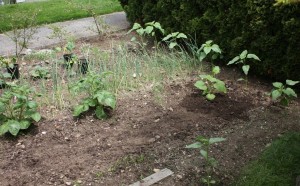 |
| By the Middle of June, not much was happening. Besdies the Garlic and the two “vounteer” potatoes, everything seen was transplants sprouted inside. |
??Besides the weather, a constant issue in my garden is the combined aphid-ant battle. I learned last year that some species of ants actually farm aphids. The aphids apparently take more sugar-filled sap out of some plants than they can digest, so they…uh… pass a very sugar-rich waste that the ants harvest. Ants “milk” the aphids like we do cows. This is so successful that the ants have actually learned to farm the aphids. They move small aphids from one part of a plant to another to spread around the feeding space, they even defend the aphids from predators. My attempts to dissuade the ants from my plants, using tanglefoot on my blueberries, and diatomaceous earth on my sunflowers, were to no avail. Using a spray-bottle or water to knock the aphids off was pretty effective, until the ants replaced the lost flock with more young aphids. I just don’t have the time to do it every day. I’m a terrible gardener.
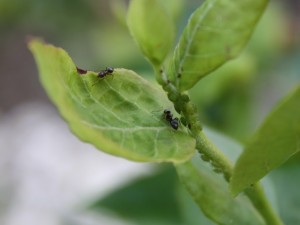 |
| Ants and aphids working together to kill my bluberry plant. (click to zoom). |
The problem with using anything more powerful (even insecticidal soap) is that it tends to knock down the natural enemies that control aphids and ants and other pests. The natural enemy of the aphid is the lady bug. So every time I see a lady bug in the garden, I know it is on my side. My experiences with ladybugs this year have included the whole life cycle.
Back in June I found a bunch of ladybug eggs on one of my sunflower plants:
Not long after, I found a bunch of freshly-hatched ladybug larvae on a leaf on my pepper plants:
Problem is, my pepper plants are amongst my tomatoes on the hot back deck, and the only two plants not being nuked by aphids. So I took matters into my own hands. I clipped the leaf off the pepper plant and attached it with a twist-tie to an aphid-infested blueberry plant in my front yard. I hoped the larvae would find a quick bounty, and stick around the garden patch where they were most needed.
That is where I learned about the ants and their defensive skills. 10 minutes after moving the leaf, there were a half dozen ants on the leaf, attacking the freshly hatched larvae. Oops. I moved the leaf to safer spot, and hopefully some of them survived! When they get big enough to defend themselves, the larvae are pretty cool looking:
And I can announce now that the weather has turned, there is a good population of ladybugs in my garden, and the aphids are almost gone completely. I still see a lot of ants around, and the sunflowers seem to have some aphids, but they are big enough to defend themselves, and they seem to be just populous enough to keep the ladybugs fed.
Oh, and now that the weather has turned, the garden is booming. Too late to get too much off the tomatoes this year I expect, but the beets, carrots, cukes and zuchs, the garlic, the blueberries, the potatoes and the onions seems to be going gangbusters, and the herb garden is loving the summer. We may even get a pumpkin to survive. Unfortunately, lettuce has been hit-and-miss this year, after a really successful last season. I really don’t know what I am doing. It sure is fun learning.
It looks like about two weeks until Fig Season, the greatest week of the year.
I am also taking part in a community science project being sponsored by Douglas College’s Institute of Urban Ecology, but I’ll talk about that later. If you are on Facebook, you can check it out now.
First update: That picture at the top shows what the garden was like inJune, with the late start, here is what it looks like now:
Second Update: I did a little research into Lady bugs, and I am supposing that little bug I photographed above is actually not a native ladybug, it is likely Harmonia axyridis, or a Japanese multi-colour ladybug. OK, because they eat a lot of aphids. but bad because are apparently displacing native species that might be better adapted to our climate. An interesting peice of background on native vs. introduced ladybugs. good reading!.
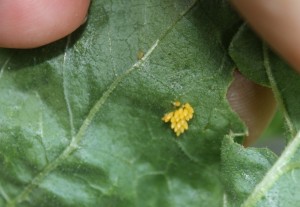
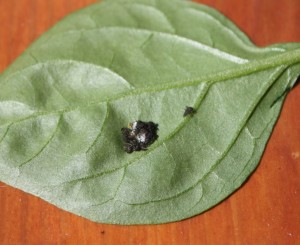
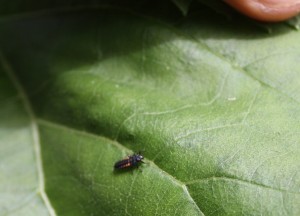
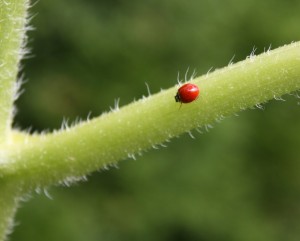
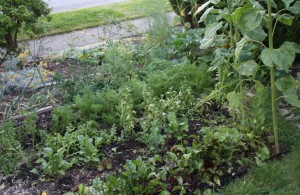
the only thing not dying in my garden right now is the tomatoes. The peas were doing okay until the tomatoes were like “hey, you didn’t need that sunlight and soil, did you? THANKS!” and honed in. Fortunately, the chickens eat all of my failed crops. They are getting sick of my beets though, and so I have had to offer them up the carrot tops. I would just like to also humbly submit that if there are figs without homes, MAH BELLY would gladly take them because although we got ourselves a fig tree, it will be 2 or 3 years before we see a reasonable crop. Last year I got 3 (count em! 1 2 3) figs that were the size of a walnut.
Jen, Trust me, when the Figs are ready, there will be figs to spare. I might have to set up a booth at the RCFM…
Good news is that I usually have an “open house” weekend and invite folks over to pick all the figs they want. However, they literally go from unripe to rotten in about 7 days (unless it rains, then it is more like 3 days), so you have to be quick. I’ll be sure to let you knew when the time comes!
Go out an find a rhubarb plant, steep the leaves in boiled water, and then spray that water onto affected plants.
Organic pesticide.
Anon: I haven’t heard of the rhubarb tincture, but I have read about cayanne and garlic teas that can work. I seem to (finally) be ahead of the bugs this year, but I will try to the (organic) chemical weapons nest year…
http://www.ecologicagardens.com/#/rhubarb-pesticide/4532666369